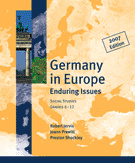Topic 1: Germany’s Changing Position in Europe and the World

Context
An understanding of the central role Germany played in the establishment of the European Union is fundamental to student understanding of the growing alliance on the continent. The study of Germany within the European Union is important for social studies classes in the schools of the United Sates. Germany is the largest economy in Europe and, in proportion to its size and population, the leading export nation in the world. The United States, a country that is twenty-six times larger than Germany by land area, and Japan both export less by value. Like Japan, though, Germany is highly dependent on other countries for raw materials and energy.Germany’s location is at the center of the continent of Europe. It is the country with the greatest number of neighbors; altogether nine: Poland and the Czech Republic to the east and southeast; Austria and Switzerland to the south; France, Luxembourg, Belgium, and the Netherlands to the west; and Denmark to the north. Austria and Switzerland are predominantly German speaking, and Poland and the Czech Republic are former Communist countries with a long tradition of cross-fertilization with German culture. The connection of Germany and the United States is evident in its cultural legacy to the U.S. through its immigrants to this country. The first Germans on American soil were craftsmen who arrived in 1608 at Jamestown, Virginia. They were the forerunners of 8 million immigrants from German-speaking countries or regions. Connections of Germany and the United States are also found in the reconstruction of Germany after total defeat and destruction in World War II. A study of reconstruction of Germany after World War II, Germany’s role in cold war conflict management, and Germany’s leadership in the move toward the European Union helps to understand the goals and issues of the new Germany.
Focus Questions
- What are the reasons for studying Germany?
- How does Germany compare to the United States and the rest of Europe in land size, GDP, and relative population?
- What is the significance of the location of Germany?

 Printable PDF
Printable PDF